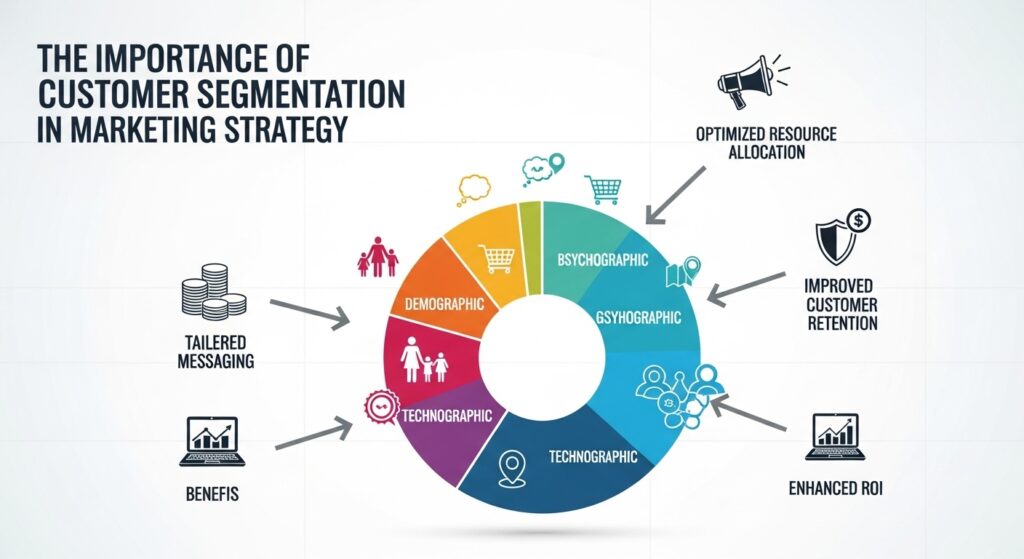In today’s competitive business landscape, understanding and catering to the unique needs of different customer groups can be a game-changer for companies aiming for growth. Customer segmentation allows businesses to divide their customer base into groups of individuals that are similar in specific ways relevant to marketing, such as age, gender, interests, and spending habits. Recognizing these nuances aids in tailoring marketing strategies to resonate with various audiences. Implementing effective customer segmentation can lead to enhanced customer satisfaction, increased loyalty, and significant improvements in sales performance.
Understanding Customer Segmentation and Its Role in Marketing
Customer segmentation is a strategy that involves dividing a company’s customers into groups that reflect similarities among customers in each group. By recognizing the heterogeneity of the marketplace, businesses can customize their offerings to specifically target the preferences of segmented groups, rather than taking a one-size-fits-all approach. This targeted method can significantly increase the effectiveness of marketing campaigns by reaching the right people with messages that resonate on a personal level.
One illustrative example of the application of customer segmentation is within the retail industry. If you’re looking to leverage customer segmentation to improve engagement and campaign effectiveness, Upland’s Adestra is a great choice. Educators, for instance, might be targeted with back-to-school campaigns that offer special discounts on supplies, while students could receive offers tailored to technology and fashion trends relevant to their interests and lifestyle.
By understanding the various dimensions of segmentation, such as demographic, psychographic, geographic, and behavioral, marketers are better equipped to design strategies that hit the mark. These dimensions offer insights into consumer behavior, allowing for more sophisticated marketing tactics and a foundation for engaged customer relationships.
How Customer Segmentation Enhances Targeted Marketing Efforts
Alt text: Consumers browsing store aisles illustrate how customer segmentation enables brands to tailor marketing to specific shopper groups.
Customer segmentation crystallizes the importance of targeted marketing. It empowers companies to focus their communication on segments that are most likely to respond to specific messages and offers. This strategic focus can result in a higher return on investment (ROI) as campaigns are more relevant and attractive to the designated audience.
Within e-commerce, segmenting by buying behavior and past purchases can yield highly targeted promotions. For instance, targeting users who have previously shown interest in outdoor equipment with promotions for hiking apparel. This can significantly increase conversion rates as the messaging directly aligns with known customer interests.
Targeted marketing also facilitates testing and optimization of marketing messages. Businesses can analyze which segments are more responsive to different types of messaging, further refining their tactics and continuously improving marketing efficiency.
The Impact of Customer Segmentation on Personalization and Customer Experience
Alt text: A team analyzes market data, using customer segmentation to drive deeper personalization and improved customer experiences.
Personalization is a cornerstone of modern marketing, and customer segmentation is its foundation. When companies understand the characteristics of their customer groups, they can personalize every interaction, creating a more engaging and memorable customer experience. This one-to-one approach builds stronger relationships and encourages customer loyalty.
Some of the most visible forms of personalized marketing can be seen in personalized email campaigns. By segmenting their email lists, businesses ensure that they send content that is relevant to each subscriber’s interests and behaviors, rather than a generic newsletter with broad appeal.
The impact of personalization goes beyond the actual product or service; it extends to every touchpoint a customer has with the brand. From targeted advertising to tailored customer service, segmentation ensures that each interaction is customized to meet the needs of different customer groups, thereby enhancing overall satisfaction.
Analyzing Customer Data for Effective Segmentation
Analyzing large sets of customer data is crucial for the creation of accurate and meaningful segments. Businesses must leverage data analytics to unearth patterns and correlations that suggest common characteristics within disparate customer groups. Employing machine learning algorithms and data mining techniques can aid in this complex process by identifying predictive attributes.
Moreover, the role of feedback cannot be overlooked. Regularly surveying customers and gathering feedback can uncover evolving preferences and sentiments, which should inform new or updated segmentation models. Social listening tools can provide real-time insights into what customers are saying about a brand across different platforms, presenting an opportunity for dynamic segmentation.
Effective segmentation, therefore, is less about gut feeling and more about rigorous data analysis. Successful companies often intertwine this analysis with their customer relationship management (CRM) systems to create a holistic view of their customers that informs every marketing decision they make.
Customer segmentation is an indispensable aspect of creating a marketing strategy that truly connects with the intended audience. It enables businesses to carve out niches in competitive markets, drive customer satisfaction, and ultimately, steer towards improved profitability and longevity.






